A ball is a round object with various uses. It is used in ball games, where the play of the game follows the state of the ball as it is hit, kicked or thrown by players. Balls can also be used for simpler activities, such as catch or juggling. Balls made from hard-wearing materials are used in engineering applications to provide very low friction bearings, known as ball bearings. Black-powder weapons use stone and metal balls as projectiles.
A football is a ball inflated with air that is used to play one of the various sports known as football. In these games, with some exceptions, goals or points are scored only when the ball enters one of two designated goal-scoring areas; football games involve the two teams each trying to move the ball in opposite directions along the field of play.
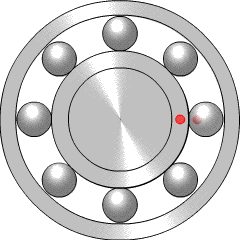
A ball bearing is a type of rolling-element bearing that uses balls to maintain the separation between the bearing races.

Physical education, also known as Phys Ed., PE, gym, or gym class, and in some Commonwealth countries as physical training or PT, is a class that pupils are required to take at school. It is taken during primary and secondary education and encourages psychomotor learning in a play or movement exploration setting to promote health.

An inflatable is an object that can be inflated with a gas, usually with air, but hydrogen, helium and nitrogen are also used. One of several advantages of an inflatable is that it can be stored in a small space when not inflated, since inflatables depend on the presence of a gas to maintain their size and shape. Function fulfillment per mass used compared with non-inflatable strategies is a key advantage. Stadium cushions, impact guards, vehicle wheel inner tubes, emergency air bags, and inflatable space structures employ the inflatable principle. Inflation occurs through several strategies: pumps, ram-air, billowing, and suction.

Tee-ball is a team sport based on and simplifying baseball and softball. It is intended as an introduction for children aged 4 to 6 to develop ball-game skills and have fun.

A billiard ball is a small, hard ball used in cue sports, such as carom billiards, pool, and snooker. The number, type, diameter, color, and pattern of the balls differ depending upon the specific game being played. Various particular ball properties such as hardness, friction coefficient and resilience are important to accuracy.

A water polo ball is a ball used in water polo and canoe polo, usually characterized by a bright yellow color and ease of grip ability, so as to allow it to be held with one hand despite its large size.

Kickball is a game and league game, similar to baseball, invented in the United States by Nicholas C. Seuss. As in baseball, one team tries to score by having its players return a ball from home base to the field and then circle the bases, while the other team tries to stop them by tagging them "out" with the ball before they can return to the home base. Instead of hitting a small, hard ball with a bat, players kick an inflated rubber ball; this makes it more accessible to young children. As in baseball, teams alternate half-innings. The team with the most runs after a predefined number of innings wins.

Crab soccer, or crab football, is an informal sport played by two teams, commonly in physical education classes. As with regular soccer, the objective is to kick an inflated ball into a goal to score the most points. Unlike soccer, players support themselves on their hands and move with their feet, in motions that make them look like crabs, a method known as crab walking. Crab soccer can be played either outdoors or in a gymnasium, and is more commonly thought of as being a sport mostly played by children. The game can be played with a regular soccer ball, but is often played with a cage ball.
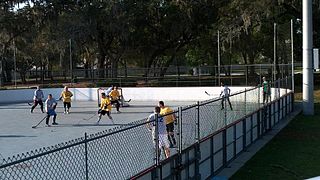
Street hockey is a variation of the sport of ice hockey where the game is played outdoors on foot, or with inline or roller skates using a ball or puck. Both ball and puck are typically designed to be played on non-ice surfaces. The object of the game is to score more goals than the opposing team by shooting the ball or puck into the opposing team's net. Street hockey in pickup form is generally played under the following guidelines since there are no "official rules" for local pickup hockey:

A medicine ball is a weighted ball roughly the diameter of the shoulders, often used for rehabilitation and strength training. The medicine ball also serves an important role in the field of sports medicine to improve strength and neuromuscular coordination. It is distinct from the inflated exercise ball, which is larger.
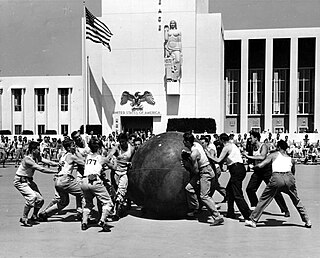
Pushball is a game played by two sides on a field usually 140 yards (130 m) long and 50 yards (46 m) wide, with a ball 6 feet (1.8 m) in diameter and 50 pounds (23 kg) in weight. Occasionally, much heavier balls were used. The sides usually number eleven each, there being five forwards, two left-wings, two right-wings and two goal-keepers. The goals consist of two upright posts 18 feet (5.5 m) high and 20 feet (6.1 m) apart with a crossbar 7 feet (2.1 m) from the ground. The game lasts for two periods with an intermission. Pushing the ball under the bar counts 5 points; lifting or throwing it over the bar counts 8. A touchdown behind goal for safety counts 2 to the attacking side.

Cricket nets are used by batsmen and bowlers to practice their cricketing techniques. They consist of a cricket pitch enclosed by netting on either side, behind, and optionally above. The bowling end is left open.

A rugby ball is an elongated ellipsoidal ball used in rugby football. Its measurements and weight are specified by World Rugby and the Rugby League International Federation, the governing bodies for both codes, rugby union and rugby league respectively.

A football, soccer ball, football ball, or association footballball is the ball used in the sport of association football. The name of the ball varies according to whether the sport is called "football", "soccer", or "association football". The ball's spherical shape, as well as its size, weight, and material composition, are specified by Law 2 of the Laws of the Game maintained by the International Football Association Board. Additional, more stringent standards are specified by FIFA and subordinate governing bodies for the balls used in the competitions they sanction.
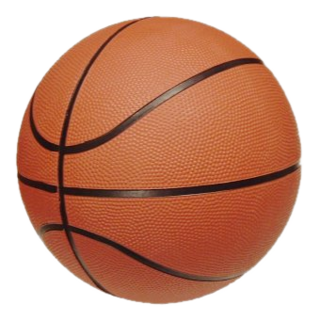
A basketball is a spherical ball used in basketball games. Basketballs usually range in size from very small promotional items only a few inches in diameter to extra large balls nearly 2 feet (60 cm) in diameter used in training exercises. For example, a youth basketball could be 27 inches (69 cm) in circumference, while a National Collegiate Athletic Association (NCAA) men's ball would be a maximum of 30 inches (76 cm) and an NCAA women's ball would be a maximum of 29 inches (74 cm). The standard for a basketball in the National Basketball Association (NBA) is 29.5 inches (75 cm) in circumference and for the Women's National Basketball Association (WNBA), a maximum circumference of 29 inches (74 cm). High school and junior leagues normally use NCAA, NBA or WNBA sized balls.
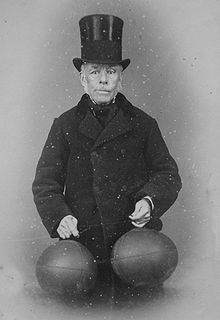
Richard Lindon was an English leatherworker who was instrumental in the development of the modern-day rugby ball by advancing the craft for ball, rubber bladder, and air pump.

Football is a family of team sports that involve, to varying degrees, kicking a ball to score a goal. Unqualified, the word football normally means the form of football that is the most popular where the word is used. Sports commonly called football include association football ; gridiron football ; Australian rules football; rugby football ; and Gaelic football. These various forms of football share to varying extent common origins and are known as football codes.

In Canada and the United States, a football is a ball, roughly in the form of a prolate spheroid, used in the context of playing gridiron football. Footballs are often made of cow hide leather, as such a material is required in professional and collegiate football. Footballs used in recreation, and in organized youth leagues, may be made of rubber or plastic materials.



















